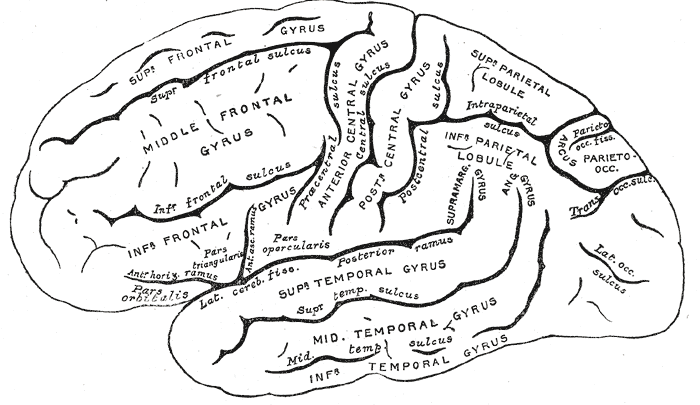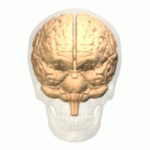|
Neural Basis Of Self
The neural basis of self is the idea of using modern concepts of neuroscience to describe and understand the biological processes that underlie humans' perception of self-understanding. The neural basis of self is closely related to the psychology of self with a deeper foundation in neurobiology. Experimental techniques In order to understand how the human mind makes the human perception of self, there are different experimental techniques. One of the more common methods of determining brain areas that pertain to different mental processes is by using Functional Magnetic Resonance Imaging. fMRI data is often used to determine activation levels in portions of the brain. fMRI measures blood flow in the brain. Areas with higher blood flow as shown on fMRI scans are said to be activated. This is due to the assumption that portions of the brain receiving increased blood flow are being used more heavily during the moment of scanning. Positron emission tomography is another method used to ... [...More Info...] [...Related Items...] OR: [Wikipedia] [Google] [Baidu] |
Neuroscience
Neuroscience is the science, scientific study of the nervous system (the brain, spinal cord, and peripheral nervous system), its functions and disorders. It is a Multidisciplinary approach, multidisciplinary science that combines physiology, anatomy, molecular biology, developmental biology, cytology, psychology, physics, computer science, chemistry, medicine, statistics, and Mathematical Modeling, mathematical modeling to understand the fundamental and emergent properties of neurons, glia and neural circuits. The understanding of the biological basis of learning, memory, behavior, perception, and consciousness has been described by Eric Kandel as the "epic challenge" of the Biology, biological sciences. The scope of neuroscience has broadened over time to include different approaches used to study the nervous system at different scales. The techniques used by neuroscientists have expanded enormously, from molecular biology, molecular and cell biology, cellular studies of indivi ... [...More Info...] [...Related Items...] OR: [Wikipedia] [Google] [Baidu] |
Posterior Cingulate Cortex
The posterior cingulate cortex (PCC) is the caudal part of the cingulate cortex, located posterior to the anterior cingulate cortex. This is the upper part of the " limbic lobe". The cingulate cortex is made up of an area around the midline of the brain. Surrounding areas include the retrosplenial cortex and the precuneus. Cytoarchitectonically the posterior cingulate cortex is associated with Brodmann areas 23 and 31. The PCC forms a central node in the default mode network of the brain. It has been shown to communicate with various brain networks simultaneously and is involved in diverse functions. Along with the precuneus, the PCC has been implicated as a neural substrate for human awareness in numerous studies of both the anesthesized and vegetative (coma) states. Imaging studies indicate a prominent role for the PCC in pain and episodic memory retrieval. Increased size of the ventral PCC is related to a decline in working memory performance. The PCC has also been str ... [...More Info...] [...Related Items...] OR: [Wikipedia] [Google] [Baidu] |
Body Position
Human positions refer to the different physical configurations that the human body can take. There are several synonyms that refer to human positioning, often used interchangeably, but having specific nuances of meaning. *''Position'' is a general term for a configuration of the human body. *'' Posture'' means an intentionally or habitually assumed position. *''Pose'' implies an artistic, aesthetic, athletic, or spiritual intention of the position. *''Attitude'' refers to postures assumed for purpose of imitation, intentional or not, as well as in some standard collocations in reference to some distinguished types of posture: "Freud never assumed a fencer's attitude, yet almost all took him for a swordsman." *''Bearing'' refers to the manner of the posture, as well as of gestures and other aspects of the conduct taking place. Basic positions While not moving, a human is usually in one of the following basic positions: All-fours This is the static form of crawling which is in ... [...More Info...] [...Related Items...] OR: [Wikipedia] [Google] [Baidu] |
Stimulus (physiology)
In physiology, a stimulus is a detectable change in the physical or chemical structure of an organism's internal or external Environment (systems), environment. The ability of an organism or Organ (anatomy), organ to detect external stimuli, so that an appropriate reaction can be made, is called sensitivity (excitability). Sensory receptors can receive information from outside the body, as in touch receptors found in the skin or light receptors in the eye, as well as from inside the body, as in chemoreceptors and mechanoreceptors. When a stimulus is detected by a sensory receptor, it can elicit a Reflex action, reflex via Transduction (physiology), stimulus transduction. An Internal stimuli, internal stimulus is often the first component of a Homeostasis, homeostatic control system. External stimuli are capable of producing systemic responses throughout the body, as in the fight-or-flight response. In order for a stimulus to be detected with high probability, its level of strengt ... [...More Info...] [...Related Items...] OR: [Wikipedia] [Google] [Baidu] |
Thoughts
In their most common sense, the terms thought and thinking refer to conscious cognitive processes that can happen independently of sensory stimulation. Their most paradigmatic forms are judging, reasoning, concept formation, problem solving, and deliberation. But other mental processes, like considering an idea, memory, or imagination, are also often included. These processes can happen internally independent of the sensory organs, unlike perception. But when understood in the widest sense, any mental event may be understood as a form of thinking, including perception and unconscious mental processes. In a slightly different sense, the term ''thought'' refers not to the mental processes themselves but to mental states or systems of ideas brought about by these processes. Various theories of thinking have been proposed, some of which aim to capture the characteristic features of thought. '' Platonists'' hold that thinking consists in discerning and inspecting Platonic forms and ... [...More Info...] [...Related Items...] OR: [Wikipedia] [Google] [Baidu] |
Extrastriate Body Area
The extrastriate body area (EBA) is a subpart of the extrastriate visual cortex involved in the visual perception of human body and body parts, akin in its respective domain to the fusiform face area, involved in the perception of human faces. The EBA was identified in 2001 by the team of Nancy Kanwisher using fMRI. Function The extrastriate body area is a category-selective region for the visual processing of static and moving images of the human body and parts of it. It is also modulated even in the absence of visual feedback from the limb movement. It is insensitive to faces and stimulus categories unrelated to the human body. The extrastriate cortex responds not only during the perception of other people's body parts but also during goal-directed movement of the participant's body parts. The extrastriate cortex represents the human body in a more integrative and dynamic manner, being able to detect an incongruence of internal body or action representations and external visual ... [...More Info...] [...Related Items...] OR: [Wikipedia] [Google] [Baidu] |
Sensory Information
A sense is a biological system used by an organism for sensation, the process of gathering information about the world through the detection of stimuli. (For example, in the human body, the brain which is part of the central nervous system receives signals from the senses which continuously receive information from the environment, interprets these signals, and causes the body to respond, either chemically or physically.) Although traditionally five human senses were identified as such (namely sight, smell, touch, taste, and hearing), it is now recognized that there are many more. Senses used by non-human organisms are even greater in variety and number. During sensation, sense organs collect various stimuli (such as a sound or smell) for transduction, meaning transformation into a form that can be understood by the brain. Sensation and perception are fundamental to nearly every aspect of an organism's cognition, behavior and thought. In organisms, a sensory organ consists ... [...More Info...] [...Related Items...] OR: [Wikipedia] [Google] [Baidu] |
Cerebral Cortex
The cerebral cortex, also known as the cerebral mantle, is the outer layer of neural tissue of the cerebrum of the brain in humans and other mammals. The cerebral cortex mostly consists of the six-layered neocortex, with just 10% consisting of allocortex. It is separated into two cortices, by the longitudinal fissure that divides the cerebrum into the left and right cerebral hemispheres. The two hemispheres are joined beneath the cortex by the corpus callosum. The cerebral cortex is the largest site of neural integration in the central nervous system. It plays a key role in attention, perception, awareness, thought, memory, language, and consciousness. The cerebral cortex is part of the brain responsible for cognition. In most mammals, apart from small mammals that have small brains, the cerebral cortex is folded, providing a greater surface area in the confined volume of the cranium. Apart from minimising brain and cranial volume, cortical folding is crucial for ... [...More Info...] [...Related Items...] OR: [Wikipedia] [Google] [Baidu] |
Temporoparietal Junction
The temporoparietal junction (TPJ) is an area of the brain where the temporal and parietal lobes meet, at the posterior end of the lateral sulcus (Sylvian fissure). The TPJ incorporates information from the thalamus and the limbic system as well as from the visual, auditory, and somatosensory systems. The TPJ also integrates information from both the external environment as well as from within the body. The TPJ is responsible for collecting all of this information and then processing it. This area is also known to play a crucial role in self–other distinctions processes and theory of mind (ToM). Furthermore, damage to the TPJ has been implicated in having adverse effects on an individual's ability to make moral decisions and has been known to produce out-of-body experiences (OBEs). Electromagnetic stimulation of the TPJ can also cause these effects. Apart from these diverse roles that the TPJ plays, it is also known for its involvement in a variety of widespread disorder ... [...More Info...] [...Related Items...] OR: [Wikipedia] [Google] [Baidu] |
Experiences
Experience refers to conscious events in general, more specifically to perceptions, or to the practical knowledge and familiarity that is produced by these conscious processes. Understood as a conscious event in the widest sense, experience involves a subject to which various items are presented. In this sense, seeing a yellow bird on a branch presents the subject with the objects "bird" and "branch", the relation between them and the property "yellow". Unreal items may be included as well, which happens when experiencing hallucinations or dreams. When understood in a more restricted sense, only sensory consciousness counts as experience. In this sense, experience is usually identified with perception and contrasted with other types of conscious events, like thinking or imagining. In a slightly different sense, experience refers not to the conscious events themselves but to the practical knowledge and familiarity they produce. In this sense, it is important that direct perceptual c ... [...More Info...] [...Related Items...] OR: [Wikipedia] [Google] [Baidu] |
Cognition
Cognition refers to "the mental action or process of acquiring knowledge and understanding through thought, experience, and the senses". It encompasses all aspects of intellectual functions and processes such as: perception, attention, thought, intelligence, the formation of knowledge, memory and working memory, judgment and evaluation, reasoning and computation, problem solving and decision making, comprehension and production of language. Imagination is also a cognitive process, it is considered as such because it involves thinking about possibilities. Cognitive processes use existing knowledge and discover new knowledge. Cognitive processes are analyzed from different perspectives within different contexts, notably in the fields of linguistics, musicology, anesthesia, neuroscience, psychiatry, psychology, education, philosophy, anthropology, biology, systemics, logic, and computer science. These and other approaches to the analysis of cognition (such as embodie ... [...More Info...] [...Related Items...] OR: [Wikipedia] [Google] [Baidu] |


.jpg)
.jpg)




